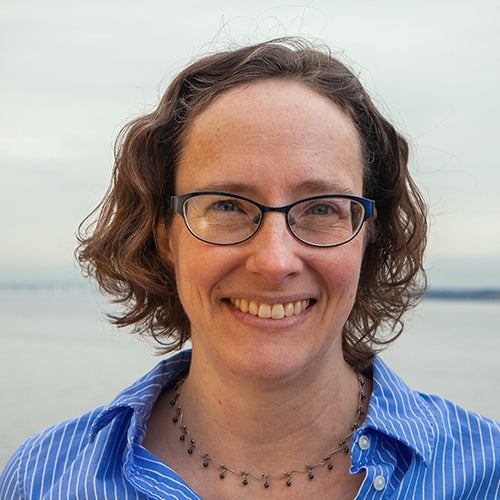- Professor of Oceanography
- Marine Geology and Geophysics
- Phone: 401.874.6838
- Email: kelley@uri.edu
- Office Location: Rm 212 Center for Atmospheric Chemistry Studies
- Website
- Accepting Students: Ph.D.
Biography
Katie Kelley earned a BA, cum laude, in Geology from Macalester College in St. Paul, MN in 1997, and was awarded a Fulbright grant to spend a year studying volcanism in the Philippines in 1997-98. She earned her PhD in Earth Sciences (2004) from Boston University, working with Terry Plank. Kelley moved to a post-doctoral position with Erik Hauri in the Department of Terrestrial Magnetism at the Carnegie Institution of Washington (now the Carnegie Institution of Science). The main themes for her doctoral work were to develop a geochemical budget for subducting altered oceanic crust at the Mariana margin, assess the mass balance of materials being subducted at the Mariana trench vs. the volcanic outputs at the Mariana arc, and evaluate how mantle melting is influenced by the additions of H2O to the mantle by subducted slabs beneath arc volcanoes and back-arc basins. Now Kelley focuses on linking the geochemical exchanges between subducted plates and the arc mantle wedge to the oxidation conditions of magmas, how this impacts the long-term evolution of the Earth’s crust and mantle.
Research
Geochemical exchange in Earth, Geochemical tracers, Geochemistry, Geology, Mantle dynamics, Petrology, Tectonics, Trace metal geochemistry, Volcanism, Volcano
My research broadly focuses on the exchanges of materials between the Earth’s surface and interior that take place at tectonic plate boundaries. Specifically, I study the lava erupted from Earth’s many types of volcanoes, as a window into the processes that melt the Earth’s interior and bring magma from depth to the surface. In areas where tectonic plates spread apart, the lava that erupts provides valuable information, such as the composition and gas content, of the Earth’s upper mantle. In areas where tectonic plates converge with each other, however, rocks and sediments from the sea floor are thrust into the mantle, polluting it and changing its composition and gas content. Volatile elements and compounds, like water and oxygen, are transported from the surface into the solid Earth’s deep interior, as if the Earth were drinking the ocean and breathing the air. The volcanoes in these convergent settings erupt different kinds of lava as a result, creating explosive volcanoes and manufacturing our continental crust.
In the laboratory, I apply novel tools of geochemistry to analyze the composition of natural volcanic glasses, minerals, and bulk rocks, as a means of finding and unraveling the processes of magma formation and geochemical evolution of the Earth’s crust and mantle. In particular, the cycling of material between the Earth’s atmosphere/ocean, crust, and mantle are intimately linked to the behavior and distribution of the volatile elements (e.g., water, carbon dioxide, sulfur) that play important roles in each of these Earth reservoirs and the ways they communicate with each other. I also ultimately seek broader links between the natural geochemistry of Earth materials and geophysical properties, dynamic models, and experimental predictions of these same conditions and processes, to drive forward our understanding of the whole Earth as a physical and chemical system.
Education
Ph.D. Earth Sciences, Boston University 2004
B.A. Geology, Macalester College 1997
I currently teach the following courses:
•OCG 110: The Ocean Planet (w/ Kincaid); Next offered Fall 2013
•OCG 525: The Chemistry of the Earth (w/ Spivack); Next offered Fall 2013
•OCG 628: Petrology of the Oceanic Crust; Next offered Spring 2015
•OCG 643: Subduction Zones (w/ Kincaid); Next offered Spring 2015
•OCG 645: High-Temperature Geochemistry; Next offered Spring 2014
Selected Publications
Cottrell & Kelley, Science (2013) Redox Heterogeneity in Mid-Ocean Ridge Basalts as a Function of Mantle Source
Kelley et al., G-Cubed (2013) Composition of plume-influenced mid-ocean ridge lavas and glasses from the Mid-Atlantic Ridge, East Pacific Rise, Galápagos Spreading Center, and Gulf of Aden
Lytle et al., G-Cubed (2012) Tracing mantle sources and Samoan influence in the northwestern Lau back-arc basin
Kelley & Cottrell, EPSL (2012) The influence of magmatic differentiation on the oxidation state of Fe in a basaltic arc magma
Cottrell & Kelley, EPSL (2011) The oxidation state of Fe in MORB glasses and the oxygen fugacity of the upper mantle
Kelley et al., Journal of Petrology (2010) Mantle Melting as a Function of Water Content beneath the Mariana Arc
Cottrell et al., Chemical Geology (2009) High-precision determination of iron oxidation state in silicate glasses using XANES
Kelley & Cottrell, Science (2009) Water and the oxidation state of subduction zone magmas

